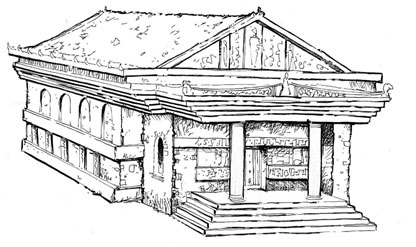The Necropolis had been built upon a low bulging hill that lay just along the Cliffs of Lost Wishes at the eastern edge of the city. As they moved a little further into the Necropolis, therefore, they were able to look over the top of the mausoleums and see seemingly endless rows of gravestones dotted with crypts of various sizes running up the hill. In the farthest distance, an the edge of the cliffs themselves, they could see an enormous, castle-like building.
I’ve talked about foreshadowing here on the Alexandrian before.
In Random GM Tip: Foreshadowing in RPGs, for example, I talk about the difficulties of foreshadowing in a non-linear, improvised medium (and three techniques you can use to work around that).
Random GM Tip: Adaptation & Reincorporation discusses how meaning is built over time through the repetition and reincorporation of creative elements. I also discuss the fact the foreshadowing can be thought of as the repetition or reincorporation of material at a point in time before the moment you actually created the material for.
For example, I know that certain features of the Necropolis are likely to become important later in the campaign, and so when the PCs arranged a funeral for Elestra’s python viper, I made a point of including some of those features (like the Dark Reliquary) into my description of the Necropolis.
This is also an example of opportunistic foreshadowing.
I didn’t plan for Elestra’s python viper to die. And I didn’t plan for her to arrange an expensive funeral for it. So I didn’t plan this bit of foreshadowing. I simply seized the opportunity while improvising the scene.
(You may note that this is not exactly hardcore foreshadowing, either. It’s literally just describing something that the characters happen to see. Which is fine. The point is to pre-establish elements so that when they later become the primary focus, they’ve already become an established part of the players’ understanding of the world.)
Session 20 is actually filled with examples of opportunistic foreshadowing.
When the PCs head to the Cathedral to seek advice from Silver Fatar Rehobath, that’s actually an example of how foreshadowing can build on itself: I had included Rehobath on the guest list for the Harvesttime party at Castle Shard because I wanted to establish his presence for later in the campaign. That’s an example of planned foreshadowing. It also put Rehobath on the PCs’ radar, though, and helped prompt them to seek his counsel here.
The inclusion of Prelate Adlam as the priest who recognizes Tee and gets her an audience with Rehobath, on the other hand, is an example of opportunistic foreshadowing. (He has his own significant role to play in future events.)
There’s also the White House: A gambling house that I know will become the center of attention later in the campaign. I’d already put together a planned bit of foreshadowing for the White House at this point (you’ll get to see that play out starting in Session 34; the actual pay-off starts in Session 91), but that’s no reason to forego the opportunistic foreshadowing here when Tee goes looking for a place to gamble.
The mrathrach game she sees being installed is also opportunistic foreshadowing, as is the strangely garbed knight she sees later in the Dreaming. (Tee’s training in the Dreaming Arts will frequently offer incredibly rich opportunities for both planned and opportunistic foreshadowing.)
If you want another example of planned foreshadowing, check out Running the Campaign: Foreshadowing Encounters.













All this about acts and foreshadowing makes me want to learn more about how you planned out the campaign in a holistic sense.
I run entirely on scenarios, and except for the initial hook, just chain react from there, with adventure hooks, “guy with a gun” or “blow something up” to provide movement if the players bog down.
I have no idea what the future holds, or what direction the game will go beyond the next few sessions, but it sounds like you had a framework or campaign skeleton all laid out, if you can predefine the act II triggers etc.
I’ll have to dig around and see what you’ve written about that. And review your book too. I’d love to have more campaign bones to hang the meat on, so to speak.